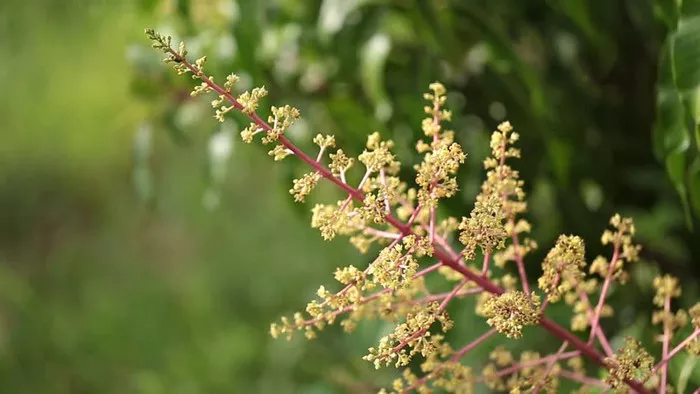Mango, often hailed as the “king of fruits,” is not only celebrated for its delicious taste but also admired for its captivating blossoms. Mango flowers, though not as renowned as the fruit itself, possess a unique beauty that captivates the beholder. In this comprehensive guide, we delve into the intricate details of mango flowers, exploring their appearance, characteristics, and significance in horticulture and culture.
Mango Flowers
Mango flowers, the precursors to the delectable fruit, are a sight to behold. These fragrant blooms adorn mango trees, adding a burst of color and fragrance to orchards and landscapes. Belonging to the genus Mangifera of the Anacardiaceae family, mangoes are native to South Asia, where they have been cultivated for thousands of years. Mango flowers, like the fruit itself, vary in appearance depending on the variety and cultivar.
Physical Characteristics
Mango flowers exhibit a range of physical characteristics that contribute to their allure. Typically small and delicate, mango flowers vary in color, size, and shape. The flowers are borne on inflorescences known as panicles, which emerge from the nodes of mature branches.
The color of mango flowers can range from creamy white to pale yellow, with some varieties even featuring hints of pink or red. The petals are often narrow and lance-shaped, arranged in clusters around the central axis of the panicle. The flowers possess a sweet, aromatic fragrance that attracts pollinators such as bees, butterflies, and flies.
One distinctive feature of mango flowers is their structure, which includes both male and female reproductive organs. Mango flowers are considered perfect flowers, meaning they contain both stamens (male reproductive organs) and pistils (female reproductive organs). This unique characteristic facilitates self-pollination, although cross-pollination by insects or wind is also common.
Varieties of Mango Flowers
The diversity of mango cultivars extends to their flowers, with each variety exhibiting unique characteristics. Some mango flowers are renowned for their striking color, while others are prized for their fragrance or size. Among the countless mango varieties cultivated worldwide, a few stand out for their distinctive flowers:
1. Alphonso: Renowned for its exceptional flavor, the Alphonso mango also boasts attractive flowers with pale yellow petals and a sweet fragrance.
2. Tommy Atkins: This popular commercial variety features large, showy flowers with creamy white petals tinged with pink.
3. Kent: Known for its juicy, fiberless fruit, the Kent mango produces small, delicate flowers with pale yellow petals and a subtle fragrance.
4. Haden: Originating from Florida, the Haden mango produces vibrant red flowers that add a splash of color to orchards.
These are just a few examples of the diverse range of mango flowers found in cultivation. Each variety offers its own aesthetic appeal, contributing to the beauty of mango orchards around the world.
Cultural Significance
Beyond their aesthetic appeal, mango flowers hold cultural significance in many societies where mangoes are cultivated. In South Asia, where mangoes are deeply ingrained in the culture, mango flowers are celebrated in art, literature, and religious rituals.
In Indian culture, mango flowers are associated with love, fertility, and prosperity. They are often used as offerings in religious ceremonies and weddings, symbolizing auspicious beginnings and blessings. Additionally, mango flowers are a recurring motif in Indian art and poetry, where they are depicted as symbols of beauty and sensuality.
In Thailand, mango flowers are celebrated during the annual Mango Blossom Festival, which coincides with the blooming season. The festival features cultural performances, culinary events, and floral displays showcasing the beauty of mango flowers.
Across cultures, mango flowers evoke feelings of joy, abundance, and renewal, making them an integral part of traditional celebrations and festivities.
Horticultural Importance
In addition to their cultural significance, mango flowers play a crucial role in horticulture and agriculture. As the precursor to the fruit, mango flowers are essential for fruit production and yield.
Mango trees require specific environmental conditions to flower and fruit successfully. Adequate sunlight, warm temperatures, and well-drained soil are essential for optimal flowering and fruiting. Additionally, proper pruning and fertilization practices can promote healthy growth and flowering in mango trees.
Commercial mango growers often employ various techniques to enhance flower production and fruit set. These may include the use of growth regulators, irrigation management, and controlled pollination methods. By optimizing flowering and fruiting, growers can maximize yields and ensure a consistent supply of high-quality mangoes.
Conclusion
Mango flowers, with their exquisite beauty and cultural significance, are a testament to the rich diversity of the natural world. From their delicate petals to their sweet fragrance, mango flowers captivate the senses and inspire admiration among all who encounter them. As symbols of love, fertility, and prosperity, mango flowers hold a special place in the hearts of those who cultivate and cherish these majestic trees.
Whether adorning orchards in tropical climates or gracing floral arrangements in distant lands, mango flowers continue to enchant and delight people around the globe. As we celebrate the beauty of mango flowers, let us also recognize their vital role in sustaining ecosystems, supporting livelihoods, and enriching the human experience.


